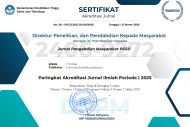Perancangan Instrumen Evaluasi Pembelajaran Berbasis Website di Sekolah Dasar Negeri 55 Air Pacah Kota Padang
Abstract
The results of observations and interviews conducted at State Elementary School of 55 Air Pacah, during online learning during the covid 19 pandemic there are 2 methods used in learning evaluation. They are (1) using conventional paper-based media that students take home and (2) sending photos of assignments or photos of questions through the WhatsApp application to parents. The use of this method makes it difficult for educators to process values. The use of website-based media in the evaluation of learning is the right solution in the current era. With a website-based evaluation instrument, correction of calculations can be made directly and students immediately get feedback. The training methods are in the form of presentations, demonstrations, hands-on practice with assistance in making evaluation instruments, and assignment methods. As a result of this service activity, educators can understand how to make website-based learning evaluation instruments and be skilled at using them. In addition, since the training was held until now, educators have applied it in online learning.
Keywords
Full Text:
PDFReferences
Adiarta, A., & Divayana, D. G. H. (2019). Pengembangan soal test digital matakuliah asesmen dan evaluasi menggunakan aplikasi Wondershare. Jurnal Pendidikan Teknologi dan Kejuruan, 16(2), 287-297. https://doi.org/10.23887/jptk-undiksha.v16i2.19199
Arifin, Z. (2009). Evaluasi Pembelajaran. PT. Remaja Rosdakarya: Bandung
Gusteti, M. U, Rifandi, R., Manda, T. G., & Melani, P. (2021). The development of 3D animated video for mathematics learning in elementary schools. Journal of Physics: Conference Series, 1940(1), 012098. https://doi.org/10.1088/1742-6596/1940/1/012098
Hendriani, M., & Gusteti, M. U. (2021). Validitas LKPD elektronik berbasis masalah terintegrasi nilai karakter percaya diri untuk keterampilan pemecahan masalah matematika SD di era digital. Jurnal Basicedu, 5(4), 2430–2439. http://www.jbasic.org/index.php/basicedu/article/view/1243
Jayadi, A., & Syarafuddin, H. M. (2020). Evaluasi pembelajaran berbasis digital online. Journal Scientific of Mandalika, 1(4), 285–287. https://doi.org/10.1016/B978-0-323-60984-5.00062-7
Masitoh, S. (2018). Blended learning berwawasan literasi digital suatu upaya meningkatkan kualitas pembelajaran dan membangun generasi emas 2045. Proceedings of the ICECRS, 1(3), 13–34. https://doi.org/10.21070/picecrs.v1i3.1377
Rahmalina, W., Gusteti, M. U., & Desmariani, E. (2020). Pelatihan membuat video pembelajaran menarik dengan smartphone pada guru adzkia. Jurnal Pengabdian Masyarakat Multidisiplin, 4(1), 26–35. https://doi.org/10.36341/jpm.v4i1.1485.
Rahmawati, A., Husnadi, M., & Haj, M. I. (2019). Implementasi Kahoot sebagai instrumen tes pembelajaran fisika di era digital. Sendika: Seminar Nasional Pendidikan, 3, 23–34.
Sutopo, H. (2011). Pengembangan evaluasi pembelajaran berbasis mulimedia dengan Flash, PHP, dan MySQL. Jurnal Informatika, 10(2), 79–85. https://doi.org/10.9744/informatika.10.2.79-85
Syarifuddin, A., & Setianingsih, R. (2013). Pengembangan instrumen Bloom Digital Assessment (BDA) pada materi pokok lingkaran di kelas VIII. MATHEdunesa, 2(2), 1-8.
DOI: https://doi.org/10.17509/jpm.v1i2.37286
Refbacks
- There are currently no refbacks.
Copyright (c) 2021 Universitas Pendidikan Indonesia

Jurnal Pengabdian Masyarakat PGSD is licensed under a Creative Commons Attribution 4.0 International License.
This journal is indexed by

.png)



1.png)

1.png)


1.png)